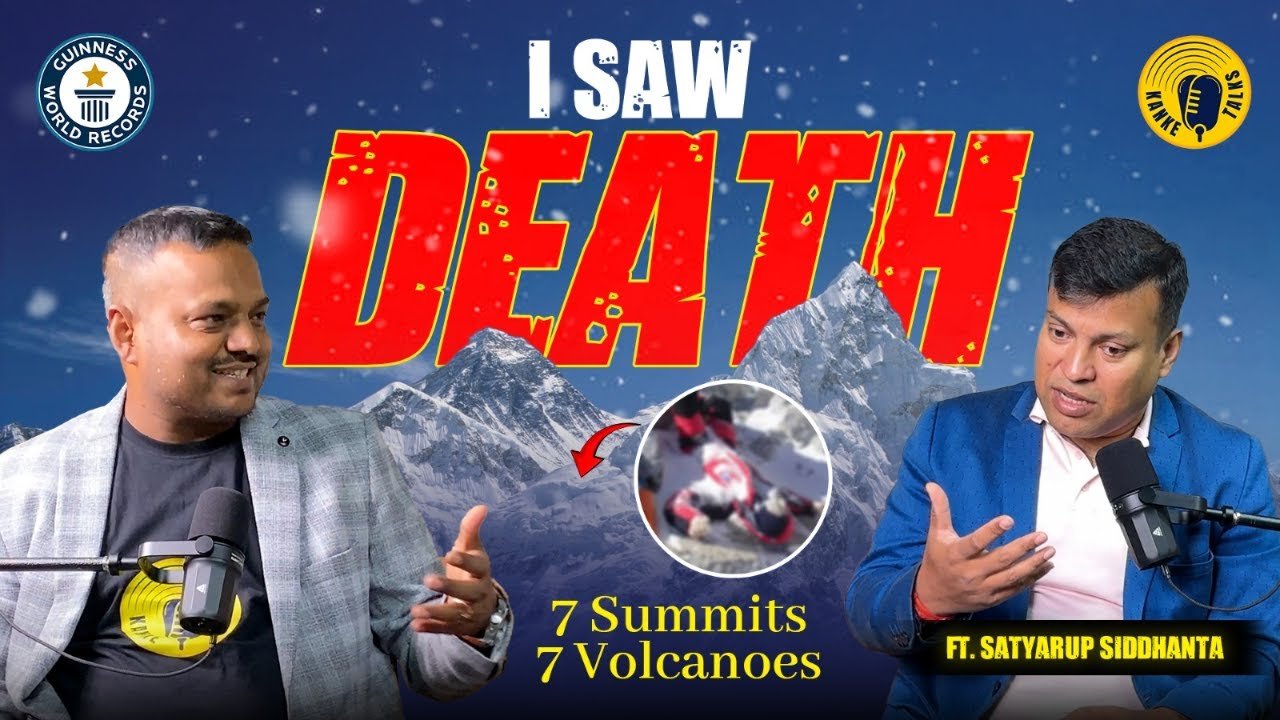The room quiets as he enters—not with pomp, but presence. There’s no need for introductions when the man before you has walked on lava, battled glaciers, and stood where very few humans ever have—on the roof of the world. Satyarup Siddhanta, the humble mountaineer turned motivational spark, isn’t just a Guinness World Record holder; he’s a living example of what happens when fear becomes your teacher and mountains become your mirrors.

Mountains Are Life, and Life Is a Mountain
When asked whether life is harder than love or climbing a mountain, Satyarup smiles knowingly. “Mountains,” he says, “are a reflection of life itself. Each climb mirrors our fears, our doubts, our victories. The real climb is always inward.”
It’s not about the summit, he explains. It’s about what you leave behind and what you discover within. Every step upward sheds a layer of ego. Every descent teaches humility. “For me, climbing mountains wasn’t about competition. It was about transformation.”
From Software to Snow Peaks
Few would dare to leave a high-paying job for a life of oxygen-starved cliffs and unpredictable weather. But Satyarup did. An accomplished software engineer, he slowly felt the corporate walls closing in. Something inside him itched for adventure. For authenticity. For purpose.
“I realized,” he shares, “that life is finite. Time is a gift. And if I was spending 10 hours a day writing code, I wanted at least some of that time to lift others up.”
He didn’t jump blindly. He transitioned smartly—freelancing, saving, and eventually starting ‘Winners and Achievers’, a startup that organizes mountaineering expeditions to Everest Base Camp, Kilimanjaro, Annapurna, and even Antarctica. And yes, it’s bootstrapped. No government grants. No corporate sponsors. Just vision, hustle, and altitude.
The Real Climb: Facing What’s Inside
“What happens when the mountain shakes you?” he asks. “The truth spills out.” That’s Satyarup’s philosophy: mountains don’t just test your lungs; they test your soul. If you’re carrying anger, fear, or ego—it shows. If you’re full of love, courage, and compassion—that too comes forth.
“Take a teacup. Shake it. If there’s tea inside, tea will spill. If there’s poison, poison. Mountains reveal what’s inside us. They don’t judge, they reflect.”
This realization changed his leadership style, his relationships, even his sense of identity.
Moments of Magic and Mortality
When Satyarup stood atop Mount Everest, the moment was surreal. He had just survived a 30-minute oxygen failure. The wind howled. The world spun at 8,848 meters. But there he was—standing where legends like Tenzing Norgay once stood.
“I didn’t feel like a conqueror,” he says. “I felt like a guest. And I knew I had to leave quickly—or I might never come back down.”
That’s the razor-thin line mountaineers walk—between glory and goodbye. It’s not the summit photo that matters; it’s the descent.
Every Mountain Is Dangerous—If You Don’t Respect It
Satyarup doesn’t rank mountains as easy or hard. “Even a simple trail can kill you if the weather turns. That’s what happened to India’s fastest Seven Summiteer, Malli Mastan Babu. He died on an ‘easy’ mountain.”
He shares the story of Gupt Parvat, an unclimbed virgin peak in Himachal Pradesh, which he and his team conquered for the first time in 2024. Treacherous rockfalls, collapsing glaciers, and vanishing base camps—everything that could go wrong, did. But they adapted, and they survived.
“Every plan must be flexible. Nature doesn’t follow your itinerary.”
Climate Change Is Already Here
Mountains are Satyarup’s classrooms—and he’s seen the syllabus change. Fast. “Glaciers are melting. Slopes are collapsing. Weather patterns are no longer predictable.”
He recalls the 2022 Draupadi Ka Danda tragedy, where over 50 trainees died due to a slab collapse caused by climate disruption.
“Climate change hits the mountains first. And yet, those sitting in AC rooms in cities can’t feel it—until their food prices go up or water runs out.”
He’s now studying ways to reduce carbon footprints, exploring carbon offset projects, and helping others embrace sustainable travel.
Rats, Rations, and Real Survival
One of his most harrowing tales comes from Papua New Guinea, where after a failed summit attempt and failed helicopter extraction, Satyarup and his team were stranded. With no food, they scavenged old expedition garbage heaps. That’s when he saw it—rats fighting over a sausage packet. Hungry, desperate, but ethical, he watched them, knowing they too were survivors. Eventually, he fought the rats for that food.
“It was Darwin’s Survival of the Fittest—right there in a garbage pit.”
That moment redefined his respect for food. “Back home, we throw away what we don’t like. But in the mountains, wasting food is a luxury you can’t afford.”
The Startup Called ‘Life’
Building a company while climbing mountains might sound insane. But for Satyarup, it’s all connected. “Startups and summits both need endurance, clarity, and resilience. You climb one client at a time, one investor at a time.”
From luxury expeditions to motivational talks for corporates and schools, he’s made mountaineering a movement—not just a personal mission. And now, he’s preparing for the North Pole, the final frontier in his journey.
The Final Message: You Are Your Mountain
To those stuck in cubicles, confused about purpose, or scared to try something new, Satyarup’s words are golden:
“Don’t wait to live your life. Whatever your mountain is—climb it. And when you do, you’ll come back changed.”
In a world obsessed with outcomes, Satyarup Siddhanta reminds us that the journey itself is the reward. And the view from the top? It’s nothing compared to what you discover inside.

No responses yet